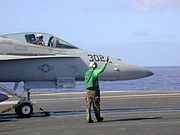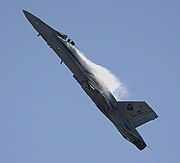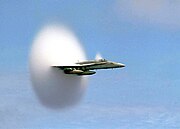The McDonnell Douglas (now Boeing) F/A-18 Hornet is an all-weather carrier-capable multirole fighter jet, designed to attack both ground and aerial targets. Designed in the 1970s for service with the United States NavyMarine Corps, the Hornet is also used by the air forces of several other nations. It has been the aerial demonstration aircraft for the U.S. Navy's Blue Angels since 1986. Its primary missions are fighter escort, fleet air defense, suppression of enemy air defenses (SEAD), interdiction, close air support and reconnaissance. Its versatility and reliability have proven it to be a valuable carrier asset, though it has been criticized for its lack of range and payload compared to its contemporaries.[1] and
The F/A-18E/F Super Hornet is a distinct, evolutionary upgrade to the F/A-18 designed to serve a complementary role with Hornets in the U.S. Navy.[2]
Origins
Development of the F/A-18 came as a result of the U.S. Navy's Naval Fighter-Attack, Experimental (VFAX) program to procure a multirole aircraft to replace the A-4 Skyhawk, the A-7 Corsair II, remaining F-4 Phantom IIs and to complement the F-14 Tomcat. Vice Admiral Kent Lee, then head of Naval Air Systems CommandWilliam D. Houser, deputy chief of naval operations for air warfare - the highest ranking naval aviator.[3] (NAVAIR), was the lead advocate for the VFAX against strong opposition from many Navy officers, including Vice Admiral

In August 1973, Congress mandated that the Navy pursue a lower-cost alternative to the F-14. GrummanMcDonnell Douglas proposed a navalized F-15, but both were nearly as expensive as the F-14.[4] That summer, Secretary of Defense Schlesinger ordered the Navy to evaluate the competitors in the Air Force's Lightweight Fighter (LWF) program, the General Dynamics YF-16Northrop YF-17.[5] The Air Force competition specified a day fighter with no strike capability. In May 1974, the House Armed Services Committee redirected $34 million from the VFAX to a new program, the Navy Air Combat Fighter (NACF),[5] intended to make maximum use of the technology developed for the LWF program.[4] proposed a stripped F-14 designated the F-14X, while and
Redesigning the YF-17
Though the YF-16 won the LWF competition, the Navy was skeptical that an aircraft with one engine and narrow landing gear could be easily or economically adapted to carrier service, and refused to adopt an F-16 derivative. The Navy fought for and won permission to develop an aircraft based on the YF-17. Since the LWF did not share the design requirements of the VFAX, the Navy asked McDonnell Douglas and Northrop to design a new aircraft around the configuration and design principles of the YF-17. The new aircraft, designated the F-18, shared not a single essential dimension or primary structure with the YF-17. Secretary of the Navy W. Graham Claytor announced on 1 March 1977 that the name of the aircraft would be "Hornet".[4]

Northrop had enlisted the aid of McDonnell Douglas as a secondary contractor on the NACF proposal to capitalize on the latter's extensive experience in building carrier aircraft, including the highly successful F-4 Phantom II. On the F-18, the two companies agreed to split the parts manufacture evenly, with McDonnell Douglas completing the final assembly, representing ~20% of the work. McDonnell Douglas built the wings, stabilators, and forward fuselage; Northrop built the center and aft fuselage and vertical stabilizers. McDonnell Douglas was the prime contractor for the naval versions.[5] Northrop would become the prime contractor and take over final assembly for the F-18L land-based version which Northrop hoped to sell on the export market.[4]
The F-18, initially known as McDonnell Douglas Model 267, was drastically modified from the YF-17 while retaining the same basic configuration. For carrier operations, the airframe, undercarriage, and arrestor hook were strengthened, folding wings and catapult attachments were added, and the landing gear widened.[6] To meet Navy range and reserves requirements, McDonnell increased fuel capacity by 4,460 pounds (2,020 kg), with the enlargement of the dorsal spine and the addition of a 96 gallon fuel cell to each wing (the YF-17 had dry wings). Most visibly, a "snag" was added to the leading edge of the wings and stabilators to prevent a flutter discovered in the F-15 stabilator. The wings and stabilators were enlarged, the aft fuselage widened by 4 inches (102 mm), and the engines canted outward at the front. These changes added 10,000 lb (4,540 kg) to the gross weight, bringing it to 37,000 lb (16,800 kg). The computer-assisted control system of the YF-17 was replaced with a wholly digital fly-by-wire system with quadruple-redundancy, the first to be installed in a production fighter.[6]
The original plan specified acquiring 780 total of three closely related models: the single seat F-18A fighter and A-18A attack aircraft, differing only in avionics, and the dual-seat TF-18A, which retained full mission capability of the F-18,[1] except with a reduced fuel load. With redesign of the stores stations and improvements in avionics and multifunction displays, it became possible to combine the A-18A and F-18A into one aircraft.[4] Starting in 1980, the aircraft began being referred to as the F/A-18A, and the designation was officially announced on 1 April 1984. The TF-18A was redesignated F/A-18B.[4][1]
Northrop's F-18L
Northrop developed the F-18L as a potential export aircraft. Since it did not have to be strengthened for carrier service, it was expected to be lighter and better performing[7], and a strong competitor to the F-16 Fighting Falcon then being offered to American allies. The F-18L was 7,700 pounds (3,493 kg) (approximately 30%) lighter than the F/A-18A, due to a lighter landing gear, removal of the wing folding mechanism, and reduced part thickness in areas. Though the aircraft retained a lightened arresting hook, the most obvious external difference was the removal of the "snags" on the leading edge of the wings and stabilators. It still retained 71% commonality with the F/A-18 by parts weight, and 90% of the high-value systems, including the avionics, radar, and ECM suite, though alternatives were offered. Unlike the F/A-18, the F-18L carried no fuel in its wings and lacked weapons stations on the intakes. It had three underwing pylons on each side instead.[8]
The partnership between the McDonnell Douglas and Northrop soured over competition for foreign sales for the two models. Northrop felt that McDonnell Douglas would put the F/A-18 in direct competition with the F-18L. In October 1979, Northrop filed a series of lawsuits charging that McDonnell was using Northrop technology developed for the F-18L for foreign sales in violation of their agreement, and asked for a moratorium on foreign sales of the Hornet via McDonnell Douglas. The case was resolved in 1985 when McDonnell agreed to pay Northrop $50 million for complete rights to the design, without any admission of wrongdoing. By then Northrop had ceased work on the F-18L, and most export orders were captured by the F-16 or the F/A-18.[8]
Into production
During flight testing, the snag on the leading edge of the stabilators was filled in, and the gap between the Leading edge extensions (LEX) and the fuselage mostly filled in. The gap, called the boundary layer air discharge (BLAD) slots, controlled the vortices generated by the LEX and presented clean air to the vertical stabilizers at high angles of attack. However, they also generated a great deal of parasitic drag, worsening the problem of the F/A-18's inadequate range. McDonnell filled in 80% of the gap, leaving a small slot to bleed air from the engine intake. This may have contributed to early problems with fatigue cracks appearing on the vertical stabilizers due to extreme aerodynamic loads, resulting in a momentary grounding in 1984 until the stabilizers were strengthened. Starting in May 1988, a small vertical fence was added to the top of each LEX to broaden the vortices and direct them away from the vertical stabilizers. This also provided a minor increase in controllability as a side effect.[9]
The first production F/A-18A flew on 12 April 1980. After a production run of 380 F/A-18As[10] (including the nine assigned to flight systems development), manufacture shifted to the F/A-18C in September 1987.[1]
Design

The F/A-18 is a twin engine, mid-wing, multi-mission tactical aircraft. It is superbly maneuverable, owing to its good thrust to weight ratio, digital fly-by-wire control system, and leading edge extensions (LEX). The LEX allow the Hornet to remain controllable at high angles of attack. This is because the LEX produce powerful vortices over the wings, creating turbulent airflow over the wings and thus delaying or eliminating the aerodynamic separation responsible for stall, allowing the Hornet's wings to generate lift several times the aircraft's weight, despite high angles of attack. The Hornet is therefore capable of extremely tight turns over a large range of speeds.
Canted vertical stabilizers are another distinguishing design element, and among the other design characteristics that enable the Hornet's excellent high angle-of-attack capability include oversized horizontal stabilators, oversized trailing edge flaps that operate as flaperons, large full-length leading-edge flaps, and flight control computer programming that multiplies the movement of each control surface at low speeds and moves the vertical rudders inboard instead of simply left and right. The Hornet's normally high angle-of-attack performance envelope was put to rigorous testing and enhanced in the NASA F-18 High Alpha Research Vehicle (HARV). NASA used the F-18 HARV to demonstrate flight handling characteristics at high angle-of-attack (alpha) of 65-70 degrees using thrust vectoring vanes.[11] F/A-18 stabilators were also used as canards on NASA's F-15S/MTD.
The Hornet was among the first aircraft to heavily utilize multi-function displays, which at the switch of a button allow the pilot to perform either fighter or attack roles or both. This "force multiplier" capability gives the operational commander more flexibility in employing tactical aircraft in a rapidly changing battle scenario. It was the first Navy aircraft to incorporate a digital multiplex avionics bus, enabling easy upgrades.[1]
The Hornet is also notable for having been designed with maintenance in mind, and as a result has required far less downtime than its heavier counterparts, the F-14 Tomcat and the A-6 Intruder. Its mean time between failure is three times greater than any other Navy strike aircraft, and requires half the maintenance time.[1] For example, whereas replacing the engine on the A-4 Skyhawk required removing the aircraft's tail, the engine on the Hornet is attached at only three points and can be directly removed without excessive disassembly. An experienced maintenance crew can remove and replace an F/A-18 engine in only a couple of hours.

The General Electric F404-GE-400 or F404-GE-402 engines powering the Hornet were also innovative in that they were designed with operability, reliability, and maintainability first. The result is an engine that, while unexceptional on paper in terms of rated performance, demonstrates exceptional robustness under a variety of conditions and is resistant to stall and flameout. By contrast, the Pratt & Whitney TF30 engines that originally powered the F-14A were notoriously prone to compressor stall and flameout under certain flight conditions.
The engine air inlets of the Hornet, like that of the F-16, are "fixed", while those of the F-4, F-14, and F-15 have variable geometry or variable ramp engine air inlets. The variable geometry enables high-speed aircraft to keep the velocity of the air reaching the engine below supersonic. This is one speed limiting factor in the Hornet design. Instead, the Hornet uses bleed air vents on the inboard surface of the engine air intake ducts to slow and reduce the amount of air reaching the engine. While not as effective as variable geometry, the bleed air technique functions well enough to achieve near Mach 2 speeds, which is within the designed mission requirements. The less sophisticated design is also more robust.
Because it was designed as a light multirole aircraft to complement the specialized F-14 and A-6 airframes, it had a relatively low internal fuel fraction. That is, its internal fuel capacity is small relative to its take-off weight, at around 23%, a fuel fraction of .23. Most aircraft of its class have a fuel fraction between .30 to .35. This situation was exacerbated by the addition of new avionics over its lifespan, further reducing the fuel fraction. This led to 330-gallon external tanks being a common sight on F/A-18s, with the centerline and inner wings stations (numbered 3, 5 and 7) being plumbed to transfer fuel.
Design evolution
In the 1990s, the US Navy faced the need to replace its aging A-6 Intruders, EA-6 Prowlers, A-7 Corsair IIsF-14 Tomcats without proper replacements in development. To answer this deficiency, the Navy had the F/A-18E/F Super Hornet developed. Despite its designation, it is not an upgrade of the F/A-18 Hornet, but rather, a new, larger airframe utilizing the design concepts of the Hornet. Hornets and Super Hornets will serve complementary roles in the US Navy carrier arsenal, until the deployment of the F-35C Lightning II, which will primarily replace F/A-18A-D Hornets. and
Taken from wikipedia

















1 comments:
aa ..
copy from wikipedia ..
Post a Comment
Im craving for ur words. ;)